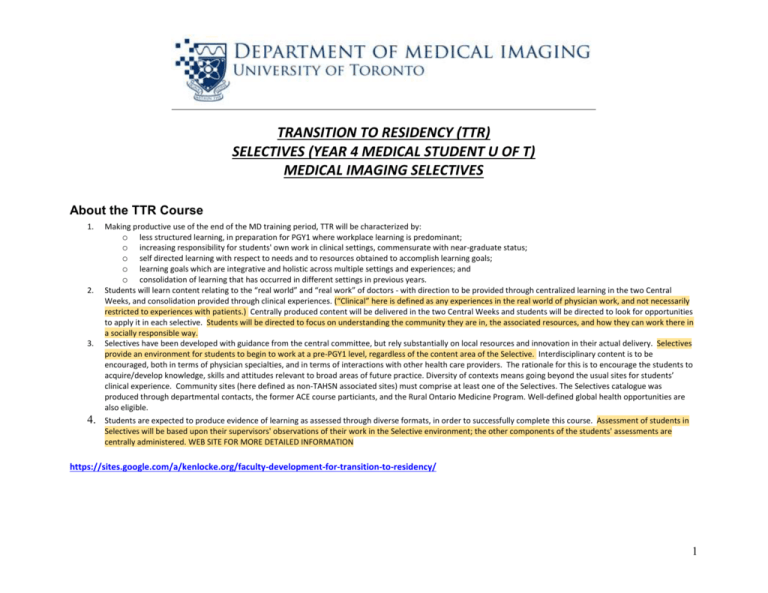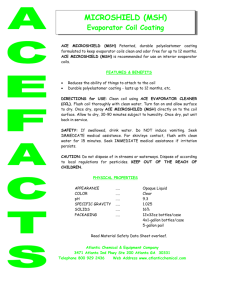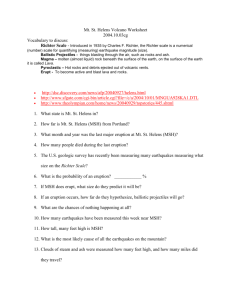Information for Students - Department of Medical Imaging
advertisement

TRANSITION TO RESIDENCY (TTR) SELECTIVES (YEAR 4 MEDICAL STUDENT U OF T) MEDICAL IMAGING SELECTIVES About the TTR Course 1. 2. 3. 4. Making productive use of the end of the MD training period, TTR will be characterized by: o less structured learning, in preparation for PGY1 where workplace learning is predominant; o increasing responsibility for students' own work in clinical settings, commensurate with near-graduate status; o self directed learning with respect to needs and to resources obtained to accomplish learning goals; o learning goals which are integrative and holistic across multiple settings and experiences; and o consolidation of learning that has occurred in different settings in previous years. Students will learn content relating to the “real world” and “real work” of doctors - with direction to be provided through centralized learning in the two Central Weeks, and consolidation provided through clinical experiences. (“Clinical” here is defined as any experiences in the real world of physician work, and not necessarily restricted to experiences with patients.) Centrally produced content will be delivered in the two Central Weeks and students will be directed to look for opportunities to apply it in each selective. Students will be directed to focus on understanding the community they are in, the associated resources, and how they can work there in a socially responsible way. Selectives have been developed with guidance from the central committee, but rely substantially on local resources and innovation in their actual delivery. Selectives provide an environment for students to begin to work at a pre-PGY1 level, regardless of the content area of the Selective. Interdisciplinary content is to be encouraged, both in terms of physician specialties, and in terms of interactions with other health care providers. The rationale for this is to encourage the students to acquire/develop knowledge, skills and attitudes relevant to broad areas of future practice. Diversity of contexts means going beyond the usual sites for students’ clinical experience. Community sites (here defined as non-TAHSN associated sites) must comprise at least one of the Selectives. The Selectives catalogue was produced through departmental contacts, the former ACE course particiants, and the Rural Ontario Medicine Program. Well-defined global health opportunities are also eligible. Students are expected to produce evidence of learning as assessed through diverse formats, in order to successfully complete this course. Assessment of students in Selectives will be based upon their supervisors' observations of their work in the Selective environment; the other components of the students' assessments are centrally administered. WEB SITE FOR MORE DETAILED INFORMATION https://sites.google.com/a/kenlocke.org/faculty-development-for-transition-to-residency/ 1 SELECTIVES IN MEDICAL IMAGING OBJECTIVES: Educate the medical student on the types of imaging modalities and their cost effective and safe utilization in diagnosing disease Teach the student the interpretation of basic imaging studies where appropriate to the residency program (Abdominal plain films , plain films of bone , CXR, Brain CT) TYPES OF MEDICAL IMAGING SELECTIVES: The medical imaging specialty is not conducive to a full 6 week selective period, except in special residency programs where image interpretation could be an important component of daily clinical work – i.e. Family Practice & Emergency Medicine Medical Imaging (MI) is best suited to be an integral part of other Specialty Selective programs, such as orthopedic surgery residency, where a short term exposure in medical imaging is sufficient to equip the medical student of nuances of medical imaging algorithms used and basic image interpretation skills. The Medical Imaging SubSelective would be an integral part of the Selective being pursued by the student, hence the Clinical Portfolio, would include a MI component to reflect the experience gained during the MI Sub Selective. MI SELECTIVES: Such selectives would be important for students entering following residency programs - Family Practice - Emergency Medicine FORMAT: - This would be a full 4 week to gain maximum learning - Could be part of the Clinical specialty or a full 6 week selective in Medical Imaging - There would be On-Line teaching tools, formal group seminars including a Pre and Post Selective test (to gauge knowledge prior to and that gained post selective) MI SUBSELECTIVES Such SubSelective would be important for students entering following residency programs - Orthopedics - Anaesthesia/ICU/Respirology - General Surgery 2 - NeuroSurgery/ENT - Pediatrics - Cardiology/Thoracic surgery FORMAT OF SUBSELECTIVES - The sessions would be a minimum of 2 full week block to ensure maximum learning - The Clinical Portfolio would include a Medical Imaging component related to the specialty (e.g. a presentation on Breast screening guidelines for family practitioner) TEACHING: - On Line teaching tools will be used ( MI University of Toronto Portal site) - Residency specific CPC Specialty and Radiology Resident weekly rounds - Formal Interactive seminars (delivered by respective specialty radiologists) o Specialty related and general radiology seminars o With a minimum quorum of 5 students EVALUATION: - Using standardised evaluation objectives - Full attendance of all sessions including participation in teaching rounds and Pre and Post Selective test - Contributions to the On-Line Teaching Site - Contributions into the Clinical Portfolio of the knowledge gained - (due to short time period of the SubSelective, vacations will not be allowed, to ensure the Selective Objectives are fulfilled) MEDICAL STUDENTS ENTERING RADIOLOGY RESIDENCY - Such students should be encouraged not to take a SubSelective in medical imaging - Should be encouraged to take on clinical specialties such as Pathology, and or clinical medicine to strengthen their clinical skills for their PGY1 year - Last part of PGY1 year is spent in Medical Imaging (Physics) Prepared by Dr Nasir Jaffer & Dr Robert Bleakney November 16, 2011 3 SUBSELECTIVES IN MEDICAL IMAGING FOR TRANSITION TO RESIDENCY (TTR) The following SubSelective in Medical Imaging will be offered No 1 TITILE OF PROPOSED MEDICAL IMAGING SUBSELECTVES IMAGING DIVISION (Most Responsible) DEPARTMENT OF PHYSICIAN OFFERING EMERGENCY FILM READING, CHEST, ABDOMEN, NEURO, MSK JDMI (MSH,UHN,WCH) Medical Imaging for Emergency Medicine Medical Imaging for Family Practice. NAME OF RESPONSIBLE PHYSICIAN ST MICHAELS SUNNYBROOK EMERGENCY FILM READING, CHEST, ABDOMEN, NEURO, MSK 2 JDMI (MSH,UHN,WCH) ST MICHAELS SUNNYBROOK JDMI (MSH,UHN,WCH) 3 Medical Imaging for General Surgery, ABDOMEN ST MICHAELS SUNNYBROOK JDMI (MSH,UHN,WCH) 4 Medical Imaging for Orthopedics, Rheumatology, Rehab Medicine MSK ST MICHAELS SUNNYBROOK JDMI (MSH,UHN,WCH) 5 Medical Imaging for Thoracic Surgery/ Respirology / Anaesthesia CHEST ST MICHAELS SUNNYBROOK JDMI (MSH,UHN,WCH) 6 Medical Imaging for Obstetrics & Gynaecology ULTRASOUND, MRI, HIGH RISK US ST MICHAELS SUNNYBROOK JDMI (MSH,UHN,WCH) 7 Medical Imaging for Neurology, Neurosurgery. NEURO ST MICHAELS SUNNYBROOK JDMI (MSH,UHN,WCH) 8 Medical Imaging for Urology. ABDOMEN 9 10 Medical Imaging for Laboratory Medicine Medical Imaging for ENT Interventional Radiology and All Modalities Radiology ST MICHAELS SUNNYBROOK JDMI (MSH,UHN,WCH) ST MICHAELS SUNNYBROOK ENT JDMI (MSH PMH) (NOT OFFERED DURNG THE A1 PERIOD OF SELECTIVES ) 4 TRANSITION TO RESIDENCY SELECTIVES IN MEDICAL IMAGING ORIENTATION FOR 4TH YEAR MED STUDENTS DAY 1: 1. Register with respective Hospital (Academy) Medical Education Office 2. Orientation with JDMI Transition To Residency Supervisors – Dr Nasir Jaffer & Dr Robert (Bob) Bleakney 3. Teaching Sessions: (Radiology Residents to conduct the sessions if more than 5 Selectives students per site) a. Whole group i. Review of Approach to Chest CT, Abdomen CT (by residents) ii. How to order Imaging studies iii. How Imaging requests are protocolled b. Self Review: On Line Teaching materials (On Portal) i. Passwords same as UTORID TRANSITION TO RESIDENCY MEDICAL IMAGING SLECTIVES SEMINAR SERIES INTRODUCTION TO REVIEWING IMAGING STUDIES A 60-90 minute session' An Approach to CT Chest and Approach to CT Abdomen The Objective: 1. 2. 3. Teach” How you review a normal CT scans of the Chest and Abdomen (using PACS). Discuss the importance of adequate history for triaging imaging studies Review the various protocols used for Chest and Abdomen CT Imaging a. Using examples of cases i. Abdomen: Appendicitis, Diverticulitis, Ischemia, Bowel Obstruction, renal colic 5 ii. Chest: Pulmonary Embolism , Aortic dissection, High resolution CT The Format: Using the PACS, review a normal CT of abdomen, and briefly teaching why we use different window level to look at different organs etc (find cases for you from our PACS Discuss the importance of history required for us to protocol and report the studies appropriately The Venue: MSH Radiology seminar room (already booked from 8-10am on March 5 2012) Start Time : 830am OTHER TEQCHING MATERIALS ON “APPROACH TO REVIEWING IMAGING STUDIES: (posted on our Undergraduate Medical Imaging Web site) CT of Brain (Narrated) Approach to CXR (narrated) Approach to COPD Approach to Plain films of Abdomen DAY 2 ONWARDS c. Rotation with Technologists – CT , MRI and Ultrasound (half day) d. Multidisciplinary Rounds i. Teaching rounds held in specific residency programs 1. List of various rounds will be provided 4. Rotations on Specific Divisions in Medical Imaging a. Schedule devised to fit your objectives outlined/Choice of residency program 5. Mid Rotation review/feedback a. Meeting to discuss: i. the students feedback ii. requests for changes in rotation schedules Final feedback a. Meeting to discuss final feedback b. Hand in Selectives Logbooks 6. 6 SUBSELECTIVE IN MEDICAL IMAGING: TTR STUDENT ACTIVITIES SUBSELECTIVE OBJECTIVE OBJECTIVE IMPLEMENTATION 1. DAILY ACTIVITIES SELF STUDY TEACHING ORGANISED TEACHING: SEMINARS STUDENT CONTRIBUTIONS (OPTIONAL) STUDENT EVALUATION 2. 3. Observe the respective Division Film review and reporting sessions. Interact with Medical Imaging Residents during their film review Observe (and participate where appropriate) medical imaging procedures (interventional, biopsies etc) Review assigned teaching files in the respective area: 1. On University of Toronto Medical Imaging Portal web site. 2. Current studies on PACs (prior to review with resident/staff radiologist) 3. Review a Pre-set of teaching files (using PACS) covering wide range of diseases Group Seminars for all Medical Imaging SubSelective TTR students on: 1. General topics such as radiation in imaging studies 2. Utility and appropriateness guidelines for medical imaging tests, 3. Approach to interpretation of imaging studies Assigned to contribute: 1. Teaching material to current On-Line and pre-set Teaching files 2. Prepare presentations on assigned topics to peers (optional) Evaluation to consist of 1. Log of daily activities 2. Most responsible radiologist to submit final evaluation 7 ASSIGNED ROTATIONS FOR SELECTIVES STUDENTS (3 WEEK ROTATION) TRANSITION TO RESIDENCY MEDICAL IMAGING SELECTIVES – week MARCH 12 Monday Tuesday Wednesday STUDENT A STUDENT B STUDENT C STUDENT D STUDENT E STUDENT F week 2 STUDENT A STUDENT B STUDENT C STUDENT D STUDENT E STUDENT F WEEK 3 STUDENT A STUDENT B STUDENT C STUDENT D STUDENT E STUDENT F RESIDENTS ON SERVICE MSH CHEST MSH CHEST MSH MSK Thursday MSH MAMMO/ABD Friday TGH CHEST MSH ABD MSH US TWH MSK MSK MSK Monday TGH CHEST MSH ABD MSH US TWH MSK TGH ABD Tuesday TGH ABD MSH US MSH CHEST TWH MSK TGH ABD Wednesday TGH ABD MSH US MSH CHEST TWH US TGH US Thursday TGH US MSH CHEST MSH MSK TWH US MSH MAMMO Friday MSH ABD MSH CHEST MSH CT/MRI PMH CT /MRI TWH NEURO MSH MSK TWH NEURO MSH MSK TGH CHEST MSH CHEST MSH MSK TGH US/ABD WCH US MSH CHEST TGH US/ABD WCH US MSH CHEST MSH US Monday TGH CT/US SINAI MRI/CT TWH MRI/US TGH GEN RAD/CT Tuesday MSH US/GEN RAD TGH US /GEN RAD TGH GEN RAD/MRI MSH GEN RAD/US TWH CT/GEN RAD TGH MRI/US Wednesday MSH ABD Thursday MSH ABD Friday MSH VIR TWH NEURO MSH CHEST MSH VIR MSH ABD TGH US/ABD TWH NEURO MSH ABD MSH HYDRO MSH ABD/NUC TGH CHEST TWH ABD MSH MURRAY ST MSH US MSH VIR TGH CARDIAC TGH VIR sinai msk MSH MSK MSH MSK MSHNUC/ABD TGH VIR tgh chest pf MSH ABD/NUC MSH MSK TGH CHEST TGH VIR TGH CARDIAC MSH NUC/ABD MSH ABD MSH ABD sinai msk resident () western msk resident () twh neuro residents () twh body resident ( sinai chest resident () tgh chest () same residents as week before twh neuro residents twh body sinai msk resident twh msk residents ) sinai chest resident ( Cardic Radiologist:- Dr Andrew Crean YELLLOW HIGHLIGHTED SESSION WITH TECHNOLOGISTS IN THE IMAGING ROOMS LEGENDS MSH = MOUNT SINAI HOSPITAL 5TH FLOOR TWH =TORONTO WESTERN HOSPITAL 3RD FLOOR TGH= TORONTO GENERAL HOSPITAL MAIN FLOOR LEFT OF TIM HORTONS PMH = PRINCESS MARGARET HOSPITAL - 3RD FLOOR WCH = WOMEN'S COLLEGE HOSPITAL 3RD FLOOR LEGENDS FOR ROTATIONS: ABD = GI AND ABDOMEN CT MSK = MUSCULOSKELETAL VIR = VASCULAR INTERVENTIONAL 8 US = ULTRASOUND MAMMO = MAMMOGRAPHY NEURO = NEURORADIOLOGY NUC = NUCLEAR MEDICINE 9







